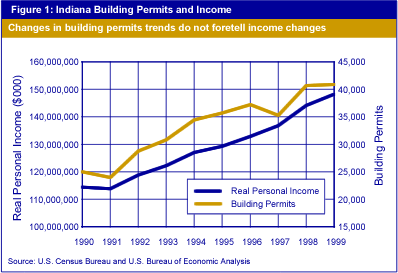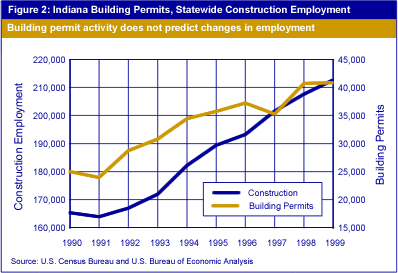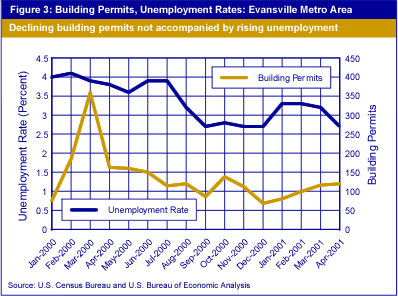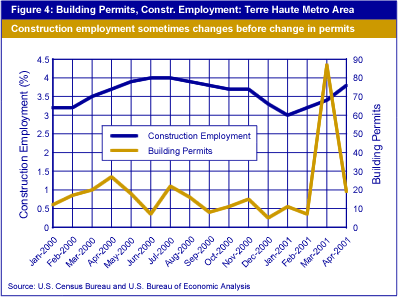Residential Building Permits Cannot Predict the Future
Building permits filed throughout Indiana are reported on a monthly basis. It's tempting to use these numbers to predict business trends. Regrettably, building permit data do not tell us much about the future.
Personal income, for example, is one measure of Indiana's economic health. Annual real personal income, adjusted to 1996 dollars, is shown in Figure 1, along with annual building permits in units. Both measures mostly rise in response to general economic growth.

The building permits line shifts significantly, however, in two places. In 1991, permits were down compared to the preceding year. This decline did not foretell any decline in income the following year. The building permit decline was followed the next year by another rise in income.
Next, note the definite drop in building permits in 1997. If we were using building permits to predict the future, we would have been disappointed. In the next year, 1998, Indiana's income was up sharply.
But surely building permit filings affect employment in the construction sector. Again, we find that's not reflected in the data. Figure 2 shows Indiana's annual building permit totals in units, compared to annual average employment in construction.

The slip in building permit filings in 1991 had almost no effect on construction employment - indeed, employment climbed slightly the following year. As for the pronounced drop in building permits in 1997, there again appears to be no obvious link to the industry. Construction employment expanded again in the year after that building permit decline.
Local effects
Those statistics, though, were statewide, and they were annual. What if we look at local building permit activity on a monthly basis? Does that tell us anything useful about a local economy?
Sadly, no.
Consider two different Hoosier metro areas. Evansville has enjoyed moderate economic growth in recent years. In official Census 2000 results, Vanderburgh, Posey and Warrick counties all saw population growth from 1990 to 2000. Evansville's metro area unemployment rate was below 3% for much of last year.
Terre Haute, on the other hand, has been struggling. Vigo County was one of the few Indiana counties to lose population from 1990 to 2000. The metro area unemployment rate ranged between 4% and 5% for much of the last 16 months, among the highest in the state.
Yet building permit data do not help us predict the different economic conditions in these two areas. In Evansville, monthly building permits trended downward through most of last year (see Figure 3). Despite this slowing of reported building permits, the metro area unemployment rate improved, from about 4% in January of last year to less than 3% at the end of the year. Construction employment in Evansville appears similarly unrelated to building permit activity.

In Terre Haute, too, building permit data have not told us much about the near-term future of the region's economy. Figure 4 shows monthly building permits reported for the Terre Haute metro area for the most recent 16 months, compared to the level of employment in the area's construction sector.

The employment numbers stayed nearly constant, even though building permits exhibited a gentle decline. In fact, the only major change in the building permit data was the large increase in March 2001, followed by a comparatively strong April. But construction industry employment had started up in February. The building permit trend didn't predict a change in employment; if anything, it was the other way around.
Building permit data may be useful for certain things. But anyone interested in the course of Indiana's economy should be skeptical. As an economic forecasting tool, they are almost not useful at all.
